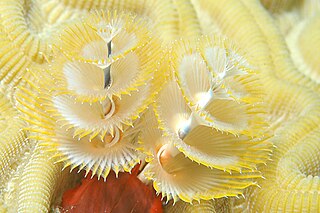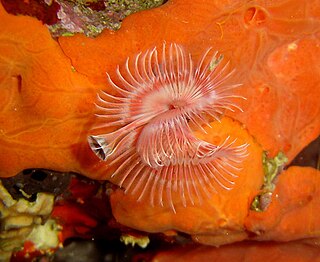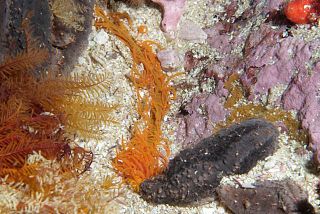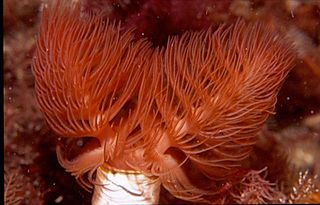
Herdmania is a genus of ascidian tunicates in the family Pyuridae.

Tridacna is a genus of large saltwater clams, marine bivalve molluscs in the subfamily Tridacninae, the giant clams. They have heavy shells, fluted with 4 to 6 folds. The mantle is brightly coloured. They inhabit shallow waters of coral reefs in warm seas of the Indo-Pacific region. These clams are popular in marine aquaria, and in some areas, such as the Philippines, members of the genus are farmed for the marine aquarium trade. They live in symbiosis with photosynthetic algae (zooxanthellae). Some species are eaten by humans.

The red-rimmed melania, also known as Malayan livebearing snails or Malayan/Malaysian trumpet snails by aquarists, is a species of freshwater snail with an operculum, a parthenogenetic, aquatic gastropod mollusk in the family Thiaridae.

Spirobranchus is a small genus of tube-building annelid fanworms in the family Serpulidae.

Pectinaria is a genus of sand tube-building annelid fanworms in the family Pectinariidae.

Tritoniopsis elegans is a species of dendronotid nudibranch. It is a marine gastropod mollusc in the family Tritoniidae and is found in the western Indo-Pacific. It was first described by the French naturalist Jean Victoire Audouin in 1826, the type specimen being found in the Red Sea.

Serpula is a genus of sessile, marine annelid tube worms that belongs to the family Serpulidae. Serpulid worms are very similar to tube worms of the closely related sabellid family, except that the former possess a cartilaginous operculum that occludes the entrance to their protective tube after the animal has withdrawn into it. The most distinctive feature of worms of the genus Serpula is their colorful fan-shaped "crown". The crown, used by these animals for respiration and alimentation, is the structure that is most commonly seen by scuba divers and other casual observers.

A radiole is a heavily ciliated feather-like tentacle found in highly organized clusters on the crowns of Canalipalpata. Canalipalpata is an order of sessile marine polychaete worms consisting of 31 families. These benthic annelid tube worms employ radioles primarily for alimentation. While their primary role is to function as an organ for filter feeding, radioles also serve as respiratory organs. Because of their role in gas exchange, radioles are often referred to as "gills".

Panulirus homarus is a species of spiny lobster that lives along the coasts of the Indian and Pacific Oceans. It lives in shallow water, and feeds on the brown mussel Perna perna. It typically grows to a length of 20–25 cm (7.9–9.8 in). Alongside the dark green nominate subspecies, two red subspecies are recognised, one around the Arabian Peninsula, and one around southern Africa. It is the subject of small-scale fishery.

Serpula vermicularis, known by common names including the calcareous tubeworm, fan worm, plume worm or red tube worm, is a species of segmented marine polychaete worm in the family Serpulidae. It is the type species of the genus Serpula and was first described by Carl Linnaeus in his 1767 12th edition of Systema Naturae. It lives in a tube into which it can retract.

Thuiaria articulata, the jointed hydroid or sea spleenwort, is a branching colonial hydroid in the family Sertulariidae.

Cirriformia capensis, commonly known as the orange thread-gilled worm, is a species of marine polychaete worm in the family Cirratulidae.
Cirriformia tentaculata, is a species of marine polychaete worm in the family Cirratulidae.

Pseudobranchiomma longa is a species of marine polychaete worms in the family Sabellidae. It is known as a feather-duster worm or a giant fanworm.

Sabella spallanzanii is a species of marine polychaete worms in the family Sabellidae. Common names include the Mediterranean fanworm, the feather duster worm, the European fan worm and the pencil worm. It is native to shallow waters in the northeastern Atlantic Ocean and the Mediterranean Sea. It has spread to various other parts of the world and is included on the Global Invasive Species Database.

Protula is a genus of marine polychaete worms in the family Serpulidae.
Acropora elegans is a species of acroporid coral that was first described by Henri Milne-Edwards in 1860. Found in sheltered, sloping reefs, this species occurs at 30 to 60 m depth. The species is listed as vulnerable on the IUCN Red List, and has a decreasing population. It is not common and has a small range, and is listed under CITES Appendix II. It is more resistant to disease than other Acropora species.
Spirobranchus kraussii, the blue coral-worm, is a species of marine invertebrate in the family Serpulidae of order Sabellida. It is native to the Indian Ocean.

Serpula columbiana, variously called the calcareous tubeworm, plume worm, fan worm, limy tube worm and red tube worm, is a species of segmented marine polychaete worm in the family Serpulidae. It is a cosmopolitan species that is found in most seas in the Northern Hemisphere including the Atlantic Ocean, the Pacific Ocean and the Indian Ocean.















